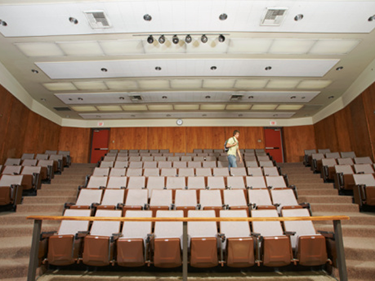One of the largest vertical markets in the audiovisual industry is higher education. Education clients often have a higher number of rooms within their facility that incorporate audiovisual technology than other large verticals, such as house of worship or corporate.
Technology in education has a very high adoption rate. Audiovisual technologies, as well as other classroom enhancing technological initiatives, such as MOOCs (Massive Open Online Courses), are literally changing the landscape for professors and administrators at colleges and universities around the country. For the sake of this article, however, we’ll limit the discussion to what currently works and what doesn’t work in higher education audiovisual technology.
What Works
Flipped Classrooms
Anyone who is paying attention to the audiovisual industry knows that every vertical market is doubling down on collaboration. Education is no different. Flipped learning has become all the rage in classrooms: students watch the professor’s lectures for homework and use in-class time to collaborate with classmates on assignments, research projects, and papers. Educators are finding tremendous benefit in accomplishing learning objectives and noticing increases in student engagement through the use of technology.
Distance Learning and Lecture Capture
Educational institutions are able to maximize their course offerings through technology, and increase their flexibility through distance learning and lecture capture systems. A professor on the main campus of a multi-site university can hold classes at several other campuses simultaneously through distance learning, or capture and edit the in-person class to become an online class for non-traditional students to take part in. These systems not only increase academic flexibility but also improve revenue streams, maximizing the return on investment as some colleges and universities see a downward trend in traditional student enrollment.
What Needs to Change
Overly Complex Designs and Interfaces
The quickest way to create a support nightmare in education is to create a system, or user interface, that is too difficult to operate. I’ll admit to having designed a system based on what technology I thought was best, and how I thought it should operate, only to wind up with a very nice system that had an incredibly low utilization. Ultimately, the use case determines the system components, not the other way around. If your use case requires two inputs and a display, there’s no need to have a control interface with 25 buttons on the first page. As the industry evolves, we must design classrooms with minimal user intervention required to operate the system, and work diligently so classroom hardware and user interfaces are as familiar as possible.
Holding onto Antiquated Technology
Anyone who follows me on Twitter knows that the struggle with antiquated technology in education is very real. I’m not sure the blame lays squarely on professors alone, though their reticence to adjust their pedagogy can be part of it. I’ve used the same VHS tape for 20 years, why would I change my curriculum now? This is something that shouldn’t ever be uttered aloud. Perhaps it also rests on administrators who immediately suffer from paralysis when they see the cost of implementing AV systems, knowing full well everything will change next year and be more-or-less obsolete. AV professionals need to do a better job of educating users as well as leadership on the benefits this technology provides, and how implementing new systems will lead to results that would maximize the ROI.
Obviously this list isn’t exhaustive. The comments are yours, what do you think works? What needs to change? And what downright doesn't work?
